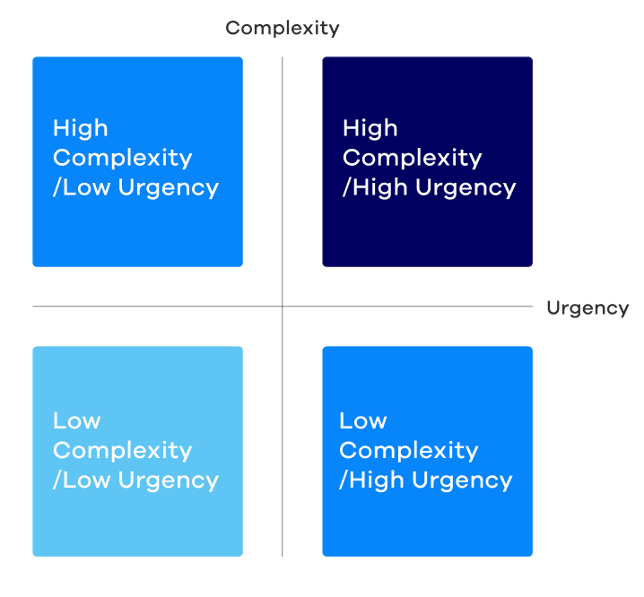Stay updated!
The best customer experience content delivered right to your inbox.
The Best Communication Channels for Complexity and Urgency
by UJET Team |
UJET previously discussed issue complexity and urgency for customer support. There isn’t an ideal single channel for customer support because issues all have different levels of complexity and urgency.
To properly resolve customer issues, the right channel needs to be used. Voice, IVR and chat are channels companies should have by default, but what is the best communication channel for each type of issue?

High complexity / low urgency
A high complexity and low urgency issue creates a problem that needs back-and-forth communication to solve but that isn’t time sensitive. Examples of this might be working to fix a software bug that requires a workaround to complete a simple task. Another issue might be assembling a product that has multiple parts, but comes with confusing instructions. The task is complex, but the issue doesn’t cause a large disruption.
Best communication channel: chat
With high complexity and low urgency problems, chat is a great channel to use. You can break down the steps to fix the issue. You could also link to an FAQ or Knowledge Base that covers the issue. If it’s an extremely technical problem, photo or video support in chat can be helpful. The agent can share visual examples of the solution that can be followed. Since chat will have text history, the customer can reference previous steps.
Use chat when customers need to be able to follow steps and can use chat history or refer to shared articles at their leisure.
High complexity / high urgency
A high complexity and high urgency problem is an issue that disrupts the customer and needs immediate resolution. Examples could be an ecommerce website has crashed during peak customer hours, a rideshare customer left an item on accident or a new API integration has broken the functionality of an app. These types of issues cause a huge disruption and customers need to get a solution asap.
Best communication channel: voice
Since customers need immediate resolution, a voice call is the best option. This gives customers a direct line of communication for a quick response. If a website crashed, the agent and customer can work through steps and get it back online. A rideshare customer can connect to the driver and schedule to get their item back. If there’s an API issue, the developer can speak to support and find out how to solve the integration issue.
Voice is the best channel when an issue causes complete disruption.
Low complexity / low urgency
Low complexity and urgency problems are defined as problems that create customer annoyance. These problems don’t affect daily life and don’t need a lengthy conversation. The best examples are asking for pre-order product information or inquiring about an upcoming product update. These issues need an answer, but they can be completed quickly with a single reply. There isn’t a need to have a lengthy back-and-forth communication.
Best communication channels: chatbot or text
For issues that can be solved without a direct conversation, a chatbot or text are the best communication channels to use. A chatbot can offer a helpful response and a text could be answered by an agent with more information.
When it’s a general question, a chatbot or text can be the perfect solution.
Low complexity / high urgency
Low complexity but high urgency problems are simple to resolve, but require the help of an agent. Great examples are changing an incorrect shipping address or updating the firmware on a smart home device. Since most retail checkout is automated, a customer would need to contact support and have the order updated with the correct information. Updated device firmware can include security updates and customers might be confused on how to update devices themselves.
Best communication channel: chat
With these type of issues, chat is the best communication channel. Agents can change a shipping address after an order is placed and also give customers the option to ask any additional order questions. If smart home devices need updates and customers aren’t sure how to do it, they can use in-app chat to speak to an agent who can explain the steps within the app.
When customers need to address urgent issues that don’t require complex solutions, chat is a great option for agents. They can provide text confirmation of updates as necessary.
Offer chat when the issue is urgent but isn’t complex. Agents can resolve these issues quickly with precision through the text conversation.
Offer the right channel to customers
Customers need more than a single channel to communicate with support. If a company only offers a single channel, each interaction can add frustration because customers are funneled regardless of urgency. When you classify incoming issues into the four complexity/urgency types, the necessary channels will become clear.
The goal of customer service is to resolve issues with streamlined and modern support. Research issue history and find out where your issues fall. It might be time to add another channel to your support department.
The best customer experience content delivered right to your inbox.